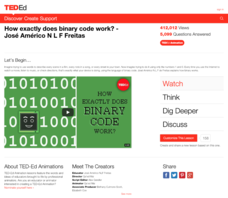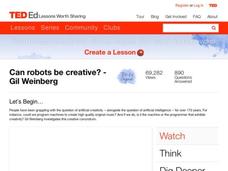Lesson Planet
EdTech Tuesday: Risk-Taking in the Classroom with Bill Selak
Interested in using technology in the classroom but worried about the risks involved? Listen as Bill Selak, a fourth-grade music teacher, describes his experiences integrating technology in the classroom and the positive impact of...
Physics Girl
Could You Replace Your Eye with a Camera?
Eyeballs or cameras—which have the best functions? The video presentations compare the important functions of the eyeball and the camera. As technology changes, cameras become more impressive, but the eyeball still out-functions the...
TED-Ed
How Does Your Smartphone Know Your Location?
When your smartphone tells you the weather of your current location or gives you directions to the nearest gas station, there's more going on that you might realize. Follow along with this short video as it explains how...
Get Chemistry Help
Chemistry Lesson: Acid-Base Neutralization Reactions
Provide your emerging chemists with the most descriptive way to perform specialized double displacement reactions possible! This video details acid-base neutralization, where acids and bases are combined to result in salt and water...
TED-Ed
The Physics of Playing Guitar
Everyone knows that guitar music rocks - but why? And how? Learn about the ways a single pluck can create sounds that resonate from string, to ear, to soul with a fascinating video about the physics of sound vibration.
Common Sense Media
What Is Digital Citizenship?
Spark scholars' interest in becoming a super digital citizen with a brief, yet informative video that details what digital citizenship is and why it's important.
American Chemical Society
Do Astronauts Need Sunscreen?
Why don't astronauts all come home with sunburns? It turns out that there are many different sources of radiation exposure for astronauts. A video outlines the radioactive dangers and protective measures astronauts must take.
Crash Course
The Medieval Islamicate World: Crash Course History of Science #7
The Medieval Islamicate World was truly a world of wonders! Clocks with gears, armillary spheres ... and robots that played music? Journey to ancient Baghdad, the center of science and math with the seventh video in a History of Science...
Code.org
How Computers Work: Binary and Data
There are two types of people in the world: those who understand binary and those who do not. Pupils watch a video that describes how computers store information using binary code. They learn how programmers can encode text, images, and...
Real Engineering
Why Are I-Beams Shaped Like an I?
There's a reason why they're called I-beams. A short Real Engineering video describes why I-beams are in the shape of an I. It considers how the beam achieves maximum bending load with the least amount of material.
Curated OER
File Sharing
It is important to keep all file sharing legal and safe. Make sure you know who you are sharing with and that it is legal. This is important to know, especially when sharing music. Watch this video to learn more important information...
Crash Course
Movies are Magic
Persistence of Vision? The Phi Phenomenon? Zoetropes? Camera Obscura? Kinetograph? What part do these concepts and inventions play in the history of movies? Find out with a short video that launches an informative playlist on film history.
Crash Course
Let's Make an AI That Destroys Video Games: Crash Course AI #13
Now that we've made a video game, we might as well figure out how to beat it. Scholars create simple video games and then program an AI to defeat them in the 13th installment of the Crash Course Artificial Intelligence series. They...
California Academy of Science
Earthquake Monitoring
Ten seconds doesn't seem like much time, but if people had that much of a warning before a big earthquake hit, it could save countless lives and prevent serious injury. The video points out that, by measuring the quick-moving P-waves and...
TED-Ed
How Exactly Does Binary Code Work?
As far as languages go, binary is pretty easy to learn. Scholars watch an informative video on binary code. It explains the basics of how binary code works, and then shows how people encode colors and sound as binary code.
American Chemical Society
Chameleons Are Masters of Nanotechnology
The oddball reptiles, chameleons, can teach animal lovers a little something about nanotechnology. Viewers peel away the layers of the chameleon skin to discover the different types of chromatophores using an episode of a larger series...
TED-Ed
Can Robots Be Creative?
What is creativity, anyway? Check out this fascinating video on the potential for creativity from artificial intelligence. The resource provides insight into the world of computer programming and algorithms, while at the same...
Real Engineering
Designing the Fastest Wheels in History
Record-setting cars need specially made tires. Young engineers watch a video in the Real Engineering series to learn about designing tires. Along the way, they study acceleration, inertia, and angular velocity.
TED-Ed
The Train Heist | Think Like A Coder, Ep 4
Robots come in handy when planning a train heist. The hero and her robot continue their quest to find artifacts to save the world. They must locate and steal the Node of Power on a specific car of a train by writing computer code for the...
Physics Girl
Are MRIs Safe?
We know about radiation from airplanes, and x-rays, but are MRIs considered safe? An informative video offers an simplified overview of how an MRI works. Then a comparison between MRIs and fMRIs opens new understanding. Finally it...
Physics Girl
Are Perpetual Motion Machines Possible?
As part of a larger series, an informative video introduces the concept of perpetual motion machines and the science proving they don't work. The narrator then shares machines that appear to work and highlights the hidden sources of energy.
Crash Course
The First Movie Camera
The second episode in a playlist on the history of film focuses on the role the Kinetograph and the Kinetoscope played in film history. The video also includes information about the contributions of scientists, Vaudeville performers, and...
American Chemical Society
The World's Smallest Robots: Rise of the Nanomachines
Think robots are big, clunky heaps of metal? Not anymore! Introduce your class to a whole new breed of robots through a video from the American Chemical Society's Reactions playlist. The resource shows what these tiny machines are made...
Crash Course
Economic Schools of Thought
Adam Smith, Karl Marx, and John Maynard Keynes held different beliefs about economic systems that evolved from their predecessors, and then shaped by their countries' economic situations. A video from Crash Course Economics...























